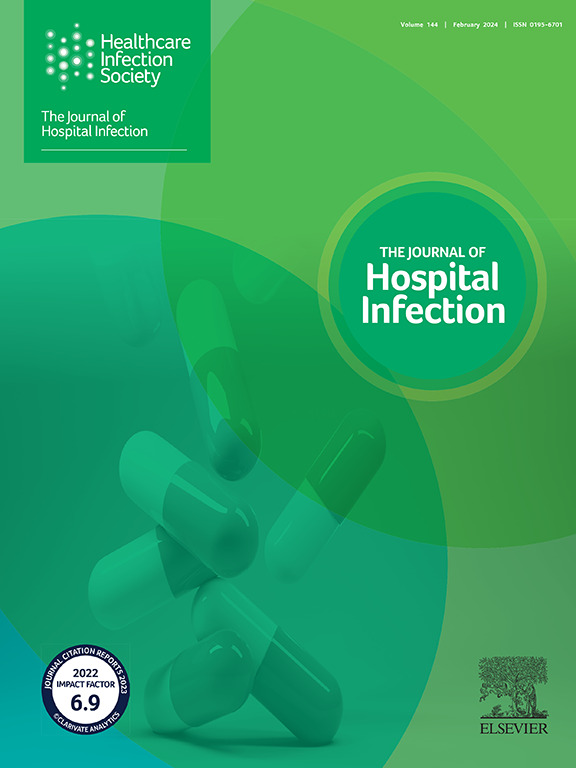在有用水安全问题的加护病房,使用连续的遥感水温监测,使临床洗手盆的供应合理化。
IF 3.1
3区 医学
Q1 INFECTIOUS DISEASES
引用次数: 0
摘要
背景:定期人工测量水温以证明对水传播病原体的充分控制是劳动密集型的,并且不能提供整个配水系统的全面概述。特别是,使用如此有限的数据集可能难以识别低使用率的出口(导致水停滞和机会性前提管道病原体生长的风险)。为了获得更准确的数据集,越来越多地使用连续遥感水温监测系统。方法:在重症监护病房15个临床洗手盆的冷热水供应处安装连续遥感水温监测系统,监测100 d内的使用情况和温度波动情况。结果:2个临床洗手盆明显为低使用率,且多次未使用超过24小时。这可能与病房糟糕的建筑设计、插座的位置和空间不足有关。这两个出口已停用,并进行了为期100天的数据监测。未激活的总天数在热水组减少了55%(82天vs. 37天未激活),在冷水组减少了36%(193天vs. 124天未激活)。结论:连续式遥感水温监测系统可以生成更全面、更准确的数据集,这是人工定期监测难以实现的。这使得两个出口得以退役,这与机组其余部分的水利用率提高有关。本文章由计算机程序翻译,如有差异,请以英文原文为准。
Use of continuous remote sensor water temperature monitoring to rationalize provision of clinical handwash basins in an ICU with water safety issues
Background
Periodic manual measurement of water temperatures to demonstrate sufficient control of waterborne pathogens is labour intensive and does not provide a comprehensive overview of the whole water distribution system. In particular, low-use outlets (which result in water stagnancy and risk of growth of opportunistic premise plumbing pathogens) may be difficult to identify using such a limited dataset. Continuous remote sensor water temperature monitoring systems are used increasingly to obtain a more accurate dataset.
Methods
A continuous remote sensor water temperature monitoring system was installed to the hot and cold water supply of 15 clinical handwash basins in an intensive care unit to monitor usage and temperature fluctuations over 100 days.
Results
Two clinical handwash basins were clearly identified as low use and were unused on multiple occasions for periods >24 h. This was likely related to the poor architectural design of the ward, placement of the outlets and lack of space. These two outlets were decommissioned and a further 100-day period of data monitoring was observed. The total number of days without activation decreased by 55% overall for the hot water supply (82 vs 37 days without activation) and by 36% overall for the cold water supply (193 vs 124 days without activation).
Conclusion
Continuous remote sensor water temperature monitoring systems can generate a more comprehensive and accurate dataset that is difficult to achieve with periodic manual monitoring. This allowed two outlets to be decommissioned, which was associated with improved water utilization across the rest of the unit.
求助全文
通过发布文献求助,成功后即可免费获取论文全文。
去求助
来源期刊

Journal of Hospital Infection
医学-传染病学
CiteScore
12.70
自引率
5.80%
发文量
271
审稿时长
19 days
期刊介绍:
The Journal of Hospital Infection is the editorially independent scientific publication of the Healthcare Infection Society. The aim of the Journal is to publish high quality research and information relating to infection prevention and control that is relevant to an international audience.
The Journal welcomes submissions that relate to all aspects of infection prevention and control in healthcare settings. This includes submissions that:
provide new insight into the epidemiology, surveillance, or prevention and control of healthcare-associated infections and antimicrobial resistance in healthcare settings;
provide new insight into cleaning, disinfection and decontamination;
provide new insight into the design of healthcare premises;
describe novel aspects of outbreaks of infection;
throw light on techniques for effective antimicrobial stewardship;
describe novel techniques (laboratory-based or point of care) for the detection of infection or antimicrobial resistance in the healthcare setting, particularly if these can be used to facilitate infection prevention and control;
improve understanding of the motivations of safe healthcare behaviour, or describe techniques for achieving behavioural and cultural change;
improve understanding of the use of IT systems in infection surveillance and prevention and control.
 求助内容:
求助内容: 应助结果提醒方式:
应助结果提醒方式:


